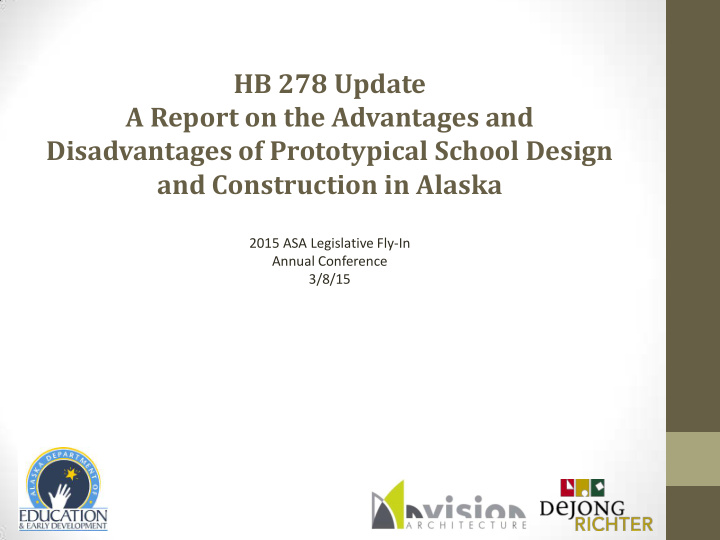



HB 278 Update A Report on the Advantages and Disadvantages of Prototypical School Design and Construction in Alaska 2015 ASA Legislative Fly-In Annual Conference 3/8/15
Introduction Purpose of the Study: HB 278 Sec. 53 School Design and Construction Report • The Department of Education And Early Development shall prepare and submit a report to the legislature not later than June 15, 2015, on the benefits and disadvantages of using prototypical designs for school construction in both the railbelt and rural areas of the state
Project Team
Report Objectives The Study Includes: • Objective #1: Conduct research at a national level to examine the successes and failures of prototypical school design and construction as a basis from which to start research at a local/state level. • Objective #2: Gain a comprehensive understanding of Alaska’s diversity with respect to culture, geography & climate and how these diversities influence school design and construction overall and in particular prototypical school design and construction. • Objective #3: Reach out to various people groups of Alaska to gather first hand information related to their experiences in the utilization of prototypical design and construction in local schools. • Objective #4: Create a well researched & documented report suitable to present to the Alaska State Legislature that informs the body of the Benefits and Disadvantages of Prototypical School Design and Construction in Alaska.
Methodology/Process Project Work Plan: Step 1: Define the Objective Step 2: Research & Analyze the Expansive Context (National Research) Step 3: Survey & Analyze the Local Context (Statewide Research) Step 4: Compare/Contrast the Findings of the Expansive Research with the Local Step 5: Final Report
Methodology/Process Step 1: Define the Objective Define the Advantages and Disadvantages of Statewide Prototypical School Design in Alaska
Methodology/Process Step 1: Define the Objective – DEFINE YOUR TERMS! Economics Education Community affordability consistency equity How will we define scalability familiarity familiarity an advantage? ?? ?? ?? Strategic Ed. adequacy local “fit - ness” alignment How will we define Design relative to homogeneity no local input a disadvantage? local climate ?? ?? ??
Methodology/Process Step 2: Research & Analyze the Expansive Context (National Research) • DeJONG-RICHTER will begin with a survey of research on the target objective • This survey will culminate in a research synopsis which will be presented to DEED and the community at large • The findings of this survey will inform questionnaire development for all stakeholders
Methodology/Process Step 3: Survey & Analyze the Local Context (Statewide Research) Our team will be spending 1-2 days in each of the 6 major geographical regions of Alaska
Methodology/Process Step 3: Survey & Analyze the Local Context (Statewide Research) • Cover all of Alaska’s diverse regions • Invite school executives and architects from each region to the meetings • Tour schools in each region (Look at schools that are considered most educationally adequate, and schools that have notable challenges) • Host a large community meeting with questionnaires and small group discussions
Methodology/Process Step 4: Compare/Contrast the Findings of the Expansive Research with the Local • DeJONG-RICHTER will collate and analyze the results from the questionnaires & tours • DeJONG-RICHTER will provide data summaries of these analyses with summary narratives. • DeJONG-RICHTER will compare/contrast the findings of the tours and questionnaires with the broader research study.
Methodology/Process Step 5: Final Report • DeJONG-RICHTER & Nvision will provide a report on the Benefits and Disadvantages for the use of Prototypical School Design and Construction Statewide in Alaska • Report will be based upon: • National Research • Local Research • Local Stakeholder Feedback
Work Summary to Date Completed: • A detailed “Work Plan” was developed • The Research & Analysis of the Expansive Context (National Research) has been completed • In Summary – Facility Prototype Design appears most advantageous in large individual districts w/ rapid growth • The Survey & Analysis of the Local Context (Statewide Research) has been started • A “Request for Information” was sent to all School Districts throughout Alaska in January 2015 • Conference Agendas & Questionnaires have been developed • Regional Conferences & the Statewide Conference have been scheduled w/ invitations sent out .
Regional Conferences Arctic Region Barrow – Mon. March 9 th , 2015 Interior Region Fairbanks – Tues. March 10 th , 2015 West Region Bethel – Thur. March 12 th , 2015 Southwest Region Kodiak – Fri. March 13 th , 2015 Southeast Region Juneau – Mon. March 30 th , 2015 Southcentral Region Mat-Su – Tues. March 31 st , 2015 Anchorage – Wed. April 1 st , 2015
Regional Conferences Purpose/Intent: The Regional Conferences are designed to communicate with and gather local perspectives from community members, educators, facility managers and the professional design and construction industry as the basis for research within the State of Alaska. Each Regional Conference will feature the following: • Presentation of National Research • Questionnaires will be completed by everyone in attendance • Interactive discussion and comments • Public Opportunity to have a voice in the research process
Statewide Conference Statewide Anchorage – Fri. April 3 rd , 2015
Statewide Conference Purpose/Intent: The Statewide Conference is designed to communicate with and gather local perspectives from the educational community exclusively. With the Regional Conferences complete, the Statewide Conference will be an in-depth examination of the findings on a more intensive level with education professionals and facility operators. The research team will engage the audience through a work session that will involve discussion and analysis of both the national and statewide research results.
Recommend
More recommend